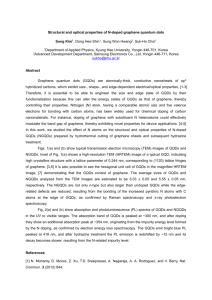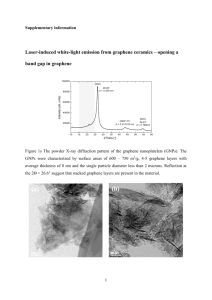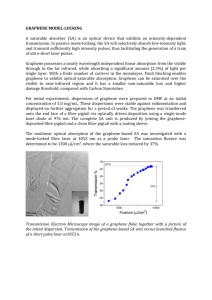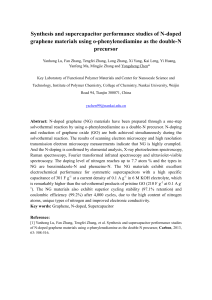Graphene2013_Bianco_Giuseppe Valerio_giuseppevalerio.bianco
advertisement
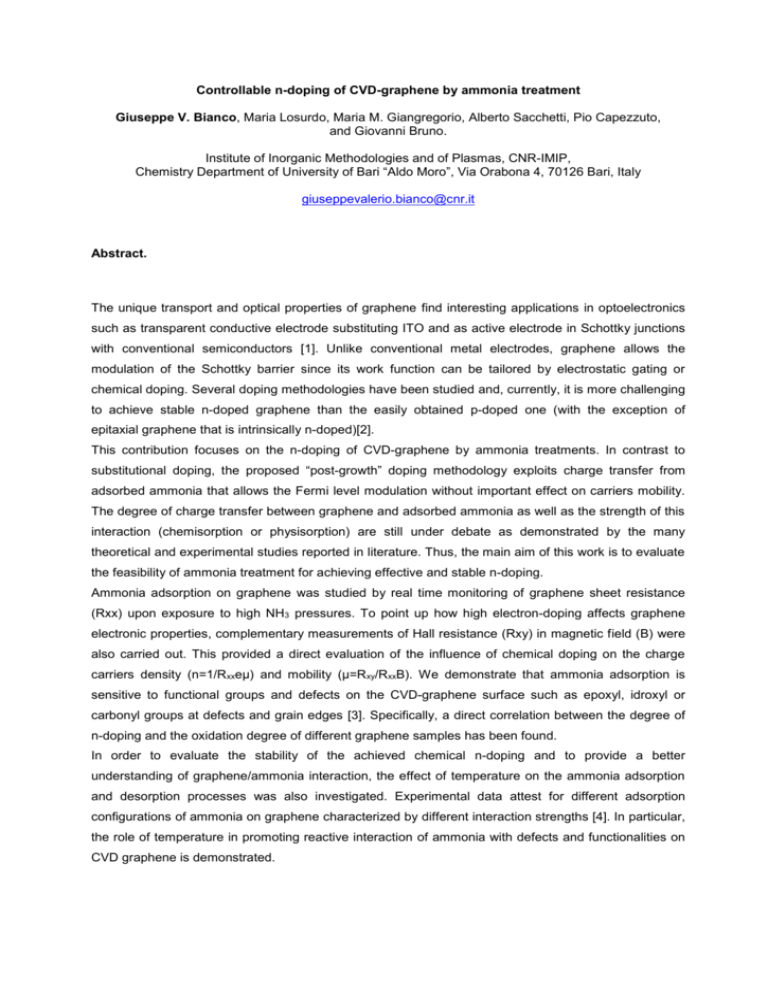
Controllable n-doping of CVD-graphene by ammonia treatment Giuseppe V. Bianco, Maria Losurdo, Maria M. Giangregorio, Alberto Sacchetti, Pio Capezzuto, and Giovanni Bruno. Institute of Inorganic Methodologies and of Plasmas, CNR-IMIP, Chemistry Department of University of Bari “Aldo Moro”, Via Orabona 4, 70126 Bari, Italy giuseppevalerio.bianco@cnr.it Abstract. The unique transport and optical properties of graphene find interesting applications in optoelectronics such as transparent conductive electrode substituting ITO and as active electrode in Schottky junctions with conventional semiconductors [1]. Unlike conventional metal electrodes, graphene allows the modulation of the Schottky barrier since its work function can be tailored by electrostatic gating or chemical doping. Several doping methodologies have been studied and, currently, it is more challenging to achieve stable n-doped graphene than the easily obtained p-doped one (with the exception of epitaxial graphene that is intrinsically n-doped)[2]. This contribution focuses on the n-doping of CVD-graphene by ammonia treatments. In contrast to substitutional doping, the proposed “post-growth” doping methodology exploits charge transfer from adsorbed ammonia that allows the Fermi level modulation without important effect on carriers mobility. The degree of charge transfer between graphene and adsorbed ammonia as well as the strength of this interaction (chemisorption or physisorption) are still under debate as demonstrated by the many theoretical and experimental studies reported in literature. Thus, the main aim of this work is to evaluate the feasibility of ammonia treatment for achieving effective and stable n-doping. Ammonia adsorption on graphene was studied by real time monitoring of graphene sheet resistance (Rxx) upon exposure to high NH3 pressures. To point up how high electron-doping affects graphene electronic properties, complementary measurements of Hall resistance (Rxy) in magnetic field (B) were also carried out. This provided a direct evaluation of the influence of chemical doping on the charge carriers density (n=1/Rxxeµ) and mobility (µ=Rxy/RxxB). We demonstrate that ammonia adsorption is sensitive to functional groups and defects on the CVD-graphene surface such as epoxyl, idroxyl or carbonyl groups at defects and grain edges [3]. Specifically, a direct correlation between the degree of n-doping and the oxidation degree of different graphene samples has been found. In order to evaluate the stability of the achieved chemical n-doping and to provide a better understanding of graphene/ammonia interaction, the effect of temperature on the ammonia adsorption and desorption processes was also investigated. Experimental data attest for different adsorption configurations of ammonia on graphene characterized by different interaction strengths [4]. In particular, the role of temperature in promoting reactive interaction of ammonia with defects and functionalities on CVD graphene is demonstrated. References [1] Yanbin An, Ashkan Behnam, Eric Pop, and Ant Ural,. Applied Physics Letters 102 (2013) 013110. [2] Sokrates T. Pantelides, Yevgeniy Puzyrev, Leonidas Tsetseris, and Bin Wang, MRS BULLETIN, 37 (2012) 1187. [3] Shaobin Tang and Zexing Cao, J. Phys. Chem. C, 116 (2012) 8778. [4] Yong-Hui Zhang, Ya-Bin Chen, Kai-Ge Zhou, Cai-Hong Liu, Jing Zeng, Hao-Li Zhang and Yong Peng, Nanotechnology 20 (2009) 185504. Time Figures 1. Real time monitoring of Sheet resistance (Rxx) and Hall resistance (Rxy) for a CVD graphene transferred on glass upon annealing at 200°C in vacuum and subsequent ammonia exposure.
